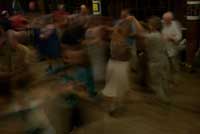|
What To Expect at a Dance |
 |
We're glad you're thinking about coming to one of our community
dance events! This note is to tell you what to expect, and to give
you some tips that will make your first experience more enjoyable.
Before you leave home: you won't need any fancy
clothes, shoes or accessories. Come as you are! If you're dressed
up, that's fine; if not, that's fine, too. Most dancers bring:
- comfortable shoes to dance in: wear shoes
that you can move in safely. You want something with a fairly
slick sole and a low heel. Even Ginger Rogers was uncomfortable
dancing in high heels. Be comfortable, wear those "sensible
shoes" your mother always told you about. Don't worry about
it your first time, but many regular dancers bring a separate
pair of dance shoes with clean soles (no street dirt) to be kind
to the wood dance floors and help them last longer.
- comfortable casual clothing: you want to wear
clothes you can move in. The usual range is from casual to dressy
casual. You may want a bandanna or handkerchief to mop your brow
- this dance raises a sweat! Please don't wear strong perfume
or cologne - some of our dancers are allergic.
- a water bottle if desired
Think comfort and safety, and you won't go wrong.
When at the dance: the first thing you'll see
is the hall itself. It's probably a church social hall, a school
hall, a community center, or a gym, and it won't be very fancy.
These are the venues with good wood floors suitable for dancing.
We try to keep our prices down to make our dances accessible to
all, so we don't spend money on decorations.
The lights will be full on. In this kind of dancing, you cover
a lot of ground, and it's important for safety to be able to see
where you're going. Change from your outside shoes to the comfortable
clean shoes you brought to dance in; your feet (and the floor)
will appreciate it!
If you've come to one of the dances with a newcomer's session,
you'll get a brief introduction to the basics of this kind of dance
before the evening itself starts. It's a good idea to do this the
first time, and maybe come back to the newcomer's session more
than once.
Dances are made up of figures, which have names like "ladies'
chain" or "do-si-do". In the course of an evening, you may do ten
different dances; the caller will tell you what figures make up
this dance, and walk the sequence through to make sure everyone
gets it. You won't be expected to have memorized the dances; you
*will* be expected to listen to the caller, and to remember some
figures.
Since some figures introduced in earlier dances will repeat in
later dances, it's a really good idea to show up at the beginning
of the evening, rather than fashionably late. (It occasionally
happens that people coming to the dance for the first time will
go out to a nice dinner, have some wine, and then show up at the
dance an hour and a half after it starts. That sets you up to have
a confusing time at the dance. For maximum enjoyment, come
on time, and unimpaired.)
You and your partner for this dance interact with other couples
up and down the set. If you don't know what you're doing, it will
be very helpful if your partner does. If you come with a date,
you should start dancing with other people immediately, and hook
up again later in the evening, when you both have some idea of
what's going on. If people try to split you up, it doesn't mean
that they don't want you to go home together -- they're trying
to help you have a successful dance experience.
Incidentally, our custom is that anybody can ask anybody else
to dance. It really doesn't mean anything more than that the person
asking wants to dance this dance. Offering or accepting an invitation
to dance at a community dance doesn't necessarily imply that anyone's
trying to pick you up. (It's not a meet-market scene. We're there
to dance - although we know of several couples who got married
after meeting at a dance.)
So, you wore comfortable shoes, you came to the pre-dance workshop,
you found a partner for the first dance. The caller tells you what
formation the dance is in (longways set, circle, square), and you
and your partner take your place.
The caller walks you through the figures of this dance, explaining
exactly how the dance works and demonstrating any moves that are
new or unfamiliar. The band strikes up a tune - driving Celtic
jigs or old-timey reels at contra dances, a wide range of tunes
at English country dances, almost anything at the barn/ceilidh
dance - and you're off, moving to the live music, sharing energy
with the band and the other dancers, seeing a new set of smiling
faces with each round of the dance.
The caller will keep prompting until everybody's got it; and the
other dancers will help you if you get confused about where to
go next. Body language is eloquent; if you're
confused at any point, notice the nearby hand offered for an allemande or
the eye contact from your neighbor inviting a swing.
When the dance ends, partners thank each other, find new partners,
and form up again, and the evening goes on like that — with
a 10-15 minute break in the middle, announcements about other dance
events, maybe an untaught couple dance (waltz, polka, hambo, schottische)
here and there, and a last waltz at the end. You go home invigorated,
flushed, and happy, with the sound of sweet music in your ears. |

